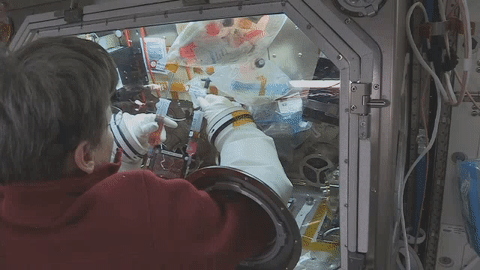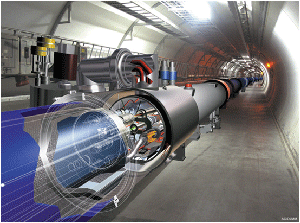ISS - Expedition 56 Mission patch.
Sept. 28, 2018
The Japan Aerospace Exploration Agency (JAXA) H-II Transfer Vehicle-7 (HTV-7) resupply ship arrived at the International Space Station on Thursday, packed with more than five tons of science and supplies for the Expedition 56 crew.
Included among the newly-arrived science is the station’s Life Sciences Glovebox, a state-of-the-art microgravity research facility that enables high-value biological research in low-Earth orbit.
Image above: Using the space station’s robotic arm, Canadarm2, Expedition 56 Commander Drew Feustel and Flight Engineer Serena Auñón-Chancellor of NASA grappled the Japan Aerospace Exploration Agency’s Kounotori H-II Transfer Vehicle (HTV 7). Image Credit: NASA.
Learn more about the science happening on station below:
Students from around the globe take photos from space station
Not everyone can go to space, but everyone can see Earth from an astronaut’s perspective with the Sally Ride Earth Knowledge Acquired by Middle School Students (Sally Ride EarthKAM) program. Students can remotely control a digital camera mounted on the space station and use it to take photographs of coastlines, mountain ranges and other features and phenomena. The images are posted online where the public and participating classrooms can view Earth from the station’s unique vantage point.
Image above: The Tiwi Islands in Northern Australia, captured during an EarthKAM imaging session. Image Credit: NASA.
This week, the crew replaced a 50mm lens with an 85mm lens and initiated an imaging session for the more than 27,000 students stemming from 33 countries involved in the program’s 63rd mission. See recent EarthKAM images here: https://www.earthkam.org/ek-images
Investigation studies complex assemblies in space
The assembly of colloidal and nanostructures is important for technological applications and for a fundamental understanding of self-assembly processes that are abundant in nature and in living matter. A better understanding of complex assembly will lead to the ability to design and grow man-made nanostructured materials with life-like functionality. The Advanced Colloids Experiment-Temperature-2 (ACE-T-2) looks at the assembly of complex structures from micron-scale colloidal particles interacting via tunable attractive interactions.
Animation above: Atomization observes the disintegration processes of low-speed water jets under various conditions to improve spray combustion processes inside rocket and jet engines. NASA astronaut Drew Feustel replaced sample syringes this week as a part of the investigation. Animation Credit: NASA.
The samples contain suspensions of colloidal particles that, upon nearing the critical solvent temperature, give rise to critical interactions between the particles. Regulating the temperature enables control of the particle interactions, leading to the growth of complex structures.
This week, the crew performed a sample module exchange within the Light Microscopy Module (LMM), contained within the Fluid Integration Rack (FIR).
Fast Neutron Spectrometer moves to Destiny Lab
Neutron spectrometers are used to make a wide range of measurements, including studies of a planetary body’s composition and measuring the flux of high-energy neutrons that could be harmful to humans. The Fast Neutron Spectrometer (FNS) investigation studies a new neutron measurement technique that is better suited for the mixed radiation fields found in deep space. Future operated and exploration missions benefit from clearer, more error-free measurement of the neutron flux present in an environment with multiple types of radiation.
Animation above: The STP-H5-Innovative Coatings Experiment (STP-H5 ICE) investigation studies new coatings for use on spacecraft in low-Earth orbit, determining their stability after two years in space. The investigation employs a set of simple exposure coupons that allow visual comparison of the effects of the space environment to a well-characterized white reference coating for this environment. Comparing photographs of these newly developed coatings to a white reference sample provides researchers information on the stability of the coatings. Animation Credit: NASA.
This week, the crew relocated the FNS from Node 1 to its new location in the Destiny Laboratory.
Space to Ground: Kounotori 7: 09/28/2018
Other work was done on these investigations:
- BEST seeks to advance use of sequencing DNA and RNA in space: https://www.nasa.gov/mission_pages/station/research/experiments/explorer/Investigation.html?#id=7687
- Atomization observes the disintegration processes of low-speed water jets under various conditions to improve spray combustion processes inside rocket and jet engines: https://www.nasa.gov/mission_pages/station/research/experiments/explorer/Investigation.html?#id=282
- ACME E-FIELD Flames establishes an electric field between the burner and a mesh electrode. Measurements are made of electric-field strength, the ion current passing through the flame, and flame characteristics, leading to a new understanding and the potential development of less polluting and more efficient combustion technology: https://www.nasa.gov/mission_pages/station/research/experiments/explorer/Investigation.html?#id=2058
- Plant Habitat-1 comprehensively compares differences in genetics, metabolism, photosynthesis, and gravity sensing between plants grown in space and on Earth: https://www.nasa.gov/mission_pages/station/research/experiments/explorer/Investigation.html?#id=2032
- BCAT-CS studies dynamic forces between sediment particles that cluster together: https://www.nasa.gov/mission_pages/station/research/experiments/explorer/Investigation.html?#id=7668
- FLUIDICS examines fluid behavior under microgravity during satellite maneuvers and the impact of capillary effect on wave turbulence without being masked by the effect of gravity: https://www.nasa.gov/mission_pages/station/research/experiments/explorer/Investigation.html?#id=2043
- Tropical Cyclone demonstrates the feasibility of studying these powerful storms from space, which would be a major step toward alerting populations and governments around the world when a dangerous storm is approaching: https://www.nasa.gov/mission_pages/station/research/experiments/explorer/Investigation.html?#id=1712
- Food Acceptability examines changes in how food appeals to crew members during their time aboard the station. Acceptability of food – whether crew members like and actually eat something – may directly affect crew caloric intake and associated nutritional benefits: https://www.nasa.gov/mission_pages/station/research/experiments/explorer/Investigation.html?#id=7562
Related links:
Expedition 56: https://www.nasa.gov/mission_pages/station/expeditions/expedition56/index.html
Sally Ride EarthKAM: https://www.nasa.gov/mission_pages/station/research/experiments/explorer/Investigation.html?#id=87
Advanced Colloids Experiment-Temperature-2 (ACE-T-2): https://www.nasa.gov/mission_pages/station/research/experiments/explorer/Investigation.html?#id=7433
Light Microscopy Module (LMM): https://www.nasa.gov/mission_pages/station/research/experiments/explorer/Facility.html?#id=531
Fluid Integration Rack (FIR): https://www.nasa.gov/mission_pages/station/research/experiments/explorer/Facility.html?#id=351
The Fast Neutron Spectrometer (FNS): https://www.nasa.gov/mission_pages/station/research/experiments/explorer/Investigation.html?#id=1841
Spot the Station: https://spotthestation.nasa.gov/
Space Station Research and Technology: https://www.nasa.gov/mission_pages/station/research/index.html
International Space Station (ISS): https://www.nasa.gov/mission_pages/station/main/index.html
Images (mentioned), Animations (mentioned), Video, Text, Credits: NASA/Michael Johnson/Yuri Guinart-Ramirez, Lead Increment Scientist Expeditions 55 & 56.
Best regards, Orbiter.ch




















































